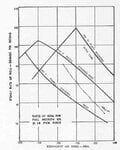Rate of roll was an important aspect of ACM. Focke Wulf (and Russian designers) seemed to be some of the first to put emphasis on that by building short and sturdy wings.
Later in the war wing strengthening became common because of the increased loads.
The Spifire evolution is a good example for that. I take this from Wikipedia (I know ):
):
"As the Spitfire gained more power and was able to fly at greater speeds the risk of aileron reversal was increasing so the Supermarine design team set about redesigning the wings to counter this possibility. The original wing design had a theoretical aileron-reversal speed of 580 mph (930 km/h),[8] which was somewhat lower than that of some contemporary fighters. The new wing of the Spitfire F Mk 21 and its successors was designed to help alleviate this problem; the wing's stiffness was increased by 47%, and a new design of aileron using piano hinges and geared trim tabs meant the theoretical aileron-reversal speed was increased to 825 mph (1,328 km/h)."
Are there any other specific speeds at which aileron reversal-appears known, especially of late-war machines?
The late P-38 had hydraulically boosted aielerons which enabled it to outroll every other fighter. Impressive if one consider its size.
Now the Fw 190D-13 had them, too. It should roll even better as it is much smaller.
Any other fighter which featured those?
Later in the war wing strengthening became common because of the increased loads.
The Spifire evolution is a good example for that. I take this from Wikipedia (I know
"As the Spitfire gained more power and was able to fly at greater speeds the risk of aileron reversal was increasing so the Supermarine design team set about redesigning the wings to counter this possibility. The original wing design had a theoretical aileron-reversal speed of 580 mph (930 km/h),[8] which was somewhat lower than that of some contemporary fighters. The new wing of the Spitfire F Mk 21 and its successors was designed to help alleviate this problem; the wing's stiffness was increased by 47%, and a new design of aileron using piano hinges and geared trim tabs meant the theoretical aileron-reversal speed was increased to 825 mph (1,328 km/h)."
Are there any other specific speeds at which aileron reversal-appears known, especially of late-war machines?
The late P-38 had hydraulically boosted aielerons which enabled it to outroll every other fighter. Impressive if one consider its size.
Now the Fw 190D-13 had them, too. It should roll even better as it is much smaller.
Any other fighter which featured those?
Last edited:

